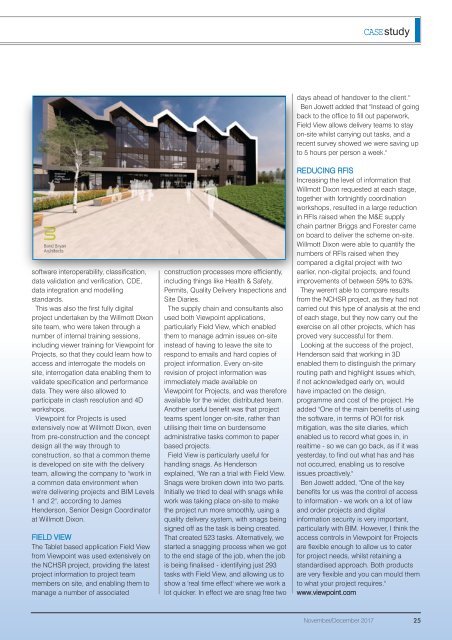Create successful ePaper yourself
Turn your PDF publications into a flip-book with our unique Google optimized e-Paper software.
CASEstudy<br />
software interoperability, classification,<br />
data validation and verification, CDE,<br />
data integration and modelling<br />
standards.<br />
This was also the first fully digital<br />
project undertaken by the Willmott Dixon<br />
site team, who were taken through a<br />
number of internal training sessions,<br />
including viewer training for Viewpoint for<br />
Projects, so that they could learn how to<br />
access and interrogate the models on<br />
site, interrogation data enabling them to<br />
validate specification and performance<br />
data. They were also allowed to<br />
participate in clash resolution and 4D<br />
workshops.<br />
Viewpoint for Projects is used<br />
extensively now at Willmott Dixon, even<br />
from pre-construction and the concept<br />
design all the way through to<br />
construction, so that a common theme<br />
is developed on site with the delivery<br />
team, allowing the company to "work in<br />
a common data environment when<br />
we're delivering projects and BIM Levels<br />
1 and 2", according to James<br />
Henderson, Senior Design Coordinator<br />
at Willmott Dixon.<br />
FIELD VIEW<br />
The Tablet based application Field View<br />
from Viewpoint was used extensively on<br />
the NCHSR project, providing the latest<br />
project information to project team<br />
members on site, and enabling them to<br />
manage a number of associated<br />
construction processes more efficiently,<br />
including things like Health & Safety,<br />
Permits, Quality Delivery Inspections and<br />
Site Diaries.<br />
The supply chain and consultants also<br />
used both Viewpoint applications,<br />
particularly Field View, which enabled<br />
them to manage admin issues on-site<br />
instead of having to leave the site to<br />
respond to emails and hard copies of<br />
project information. Every on-site<br />
revision of project information was<br />
immediately made available on<br />
Viewpoint for Projects, and was therefore<br />
available for the wider, distributed team.<br />
Another useful benefit was that project<br />
teams spent longer on-site, rather than<br />
utilising their time on burdensome<br />
administrative tasks common to paper<br />
based projects.<br />
Field View is particularly useful for<br />
handling snags. As Henderson<br />
explained, "We ran a trial with Field View.<br />
Snags were broken down into two parts.<br />
Initially we tried to deal with snags while<br />
work was taking place on-site to make<br />
the project run more smoothly, using a<br />
quality delivery system, with snags being<br />
signed off as the task is being created.<br />
That created 523 tasks. Alternatively, we<br />
started a snagging process when we got<br />
to the end stage of the job, when the job<br />
is being finalised - identifying just 293<br />
tasks with Field View, and allowing us to<br />
show a 'real time effect' where we work a<br />
lot quicker. In effect we are snag free two<br />
days ahead of handover to the client."<br />
Ben Jowett added that "Instead of going<br />
back to the office to fill out paperwork,<br />
Field View allows delivery teams to stay<br />
on-site whilst carrying out tasks, and a<br />
recent survey showed we were saving up<br />
to 5 hours per person a week."<br />
REDUCING RFIS<br />
Increasing the level of information that<br />
Willmott Dixon requested at each stage,<br />
together with fortnightly coordination<br />
workshops, resulted in a large reduction<br />
in RFIs raised when the M&E supply<br />
chain partner Briggs and Forester came<br />
on board to deliver the scheme on-site.<br />
Willmott Dixon were able to quantify the<br />
numbers of RFIs raised when they<br />
compared a digital project with two<br />
earlier, non-digital projects, and found<br />
improvements of between 59% to 63%.<br />
They weren't able to compare results<br />
from the NCHSR project, as they had not<br />
carried out this type of analysis at the end<br />
of each stage, but they now carry out the<br />
exercise on all other projects, which has<br />
proved very successful for them.<br />
Looking at the success of the project,<br />
Henderson said that working in 3D<br />
enabled them to distinguish the primary<br />
routing path and highlight issues which,<br />
if not acknowledged early on, would<br />
have impacted on the design,<br />
programme and cost of the project. He<br />
added "One of the main benefits of using<br />
the software, in terms of ROI for risk<br />
mitigation, was the site diaries, which<br />
enabled us to record what goes in, in<br />
realtime - so we can go back, as if it was<br />
yesterday, to find out what has and has<br />
not occurred, enabling us to resolve<br />
issues proactively."<br />
Ben Jowett added, "One of the key<br />
benefits for us was the control of access<br />
to information - we work on a lot of law<br />
and order projects and digital<br />
information security is very important,<br />
particularly with BIM. However, I think the<br />
access controls in Viewpoint for Projects<br />
are flexible enough to allow us to cater<br />
for project needs, whilst retaining a<br />
standardised approach. Both products<br />
are very flexible and you can mould them<br />
to what your project requires."<br />
www.viewpoint.com<br />
November/December 2017 25

















